
Two-dimensional (2D) materials really are not so much new as they are different.
“They are not entirely novel materials,” explained Nitin Samarth. “Many are formed from three-dimensional crystalline materials that we’ve studied for a long time; we just didn’t know until recently that we could make them into this purely two- dimensional form.”
But what is a 2D material, and how is one made? “Well, you have to be, in some sense, a quantum tailor,” said Samarth. “You have to stitch atoms together in a particular way.”
In essence, he explains, this entails taking a given material and reducing one dimension of it to the nanometer—or one billionth of a meter—scale.
Imagine a large crystal, big enough to ll the palm of your hand, that you would shrink just the thickness of—without changing its length and width—to only a few atoms; the crystal would still be large enough to ll your hand, but its depth or height in your hand would be almost imperceptibly thin.
“This is a material, then, that you can say is no longer three-dimensional, but is two-dimensional— because its electrons are free to move in only two directions,” said Samarth. “Their motion in the third, or ‘Z’ direction, is constrained, but in the ‘X’ and ‘Y’ directions they’re free to move.”
In this 2D form, materials exhibit very different electronic, optical, and magnetic properties— primarily because of quantum mechanics. At the quantum scale, electrons behave as waves, and the vibrations of these waves can be controlled by constraining the electrons’ motion at nanometer dimensions.
“Sort of like taking a guitar string and, depending on what the length of the string is and how much tension you put into it, you get different frequencies—it vibrates in different modes,” Samarth explained. “Similarly, in these materials, you can manipulate one dimension so that the electrons essentially vibrate with different frequencies.”
Over the past decade, scientists have created a number of 2D materials by stripping away ultrathin, 2D layers from three-dimensional crystals. But while they have learned much by this approach, scientists are still challenged in being able to manufacture 2D materials at what is known as the “wafer” scale—a crucial step in making them useful for technology such as the silicon-based microprocessors that are the heart of all modern computers.
“This was the challenge that a group of us at Penn State decided to take up,” said Samarth. “We approached the National Science Foundation with a proposal for funding a materials innovation platform—a national facility where users could come and learn how to synthesize new types of 2D materials. We came up with the idea of the Two- Dimensional Crystal Consortium (2DCC), which was subsequently funded by the NSF at roughly $18 million for five years.”

Led by Joan Redwing (materials science and engineering), Vin Crespi (physics), and Samarth, the 2DCC is now a world-class resource for the broader scientific community—training materials scientists, physicists, chemists, electrical engineers, and other researchers to advance the wafer-scale synthesis of 2D materials and enabling them to study these materials with instruments that are absolutely state-of-the-art.
“A key component of this facility is the sophisticated synthesis and characterization apparatus in the basement of Davey Lab,” Samarth explained. “The apparatus, which resembles a stainless-steel octopus from a science-fiction novel, will allow users to study 2D materials in their newly synthesized state, pristine and still in vacuum—directly imaging these materials at the atomic scale, measuring the propagation of electrons, even providing a direct picture of their vibration frequencies or ‘energy bands’.”
These incredible new capabilities will be truly groundbreaking for users of the facility, but “the really thrilling part,” Samarth said, “is that we’re not just doing this for ourselves. While user facilities have long existed for characterization experiments—for instance, synchrotrons at national labs—it’s not a common approach to materials synthesis. We are trying to provide an opportunity for a large community of scientists to work at the very frontiers of an emerging eld. That’s where exciting science always happens.”
Nitin Samarth is the George A. and Margaret M. Downsbrough Department Head and a professor of physics at Penn State.
